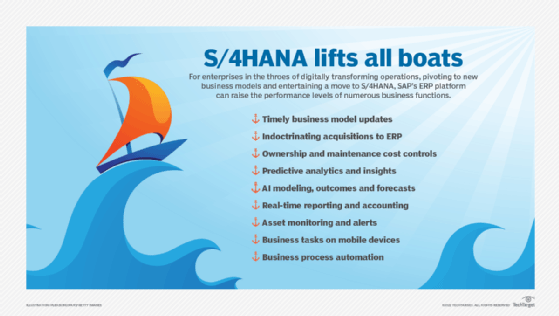9 top SAP S/4HANA benefits for businesses
For today's highly nimble business models, SAP S/4HANA can provide speed, flexibility, simplicity, faster analytics, lower costs and the strength of HANA's in-memory database.
SAP customers are faced with some tough decisions. Among their options: Stay on ECC and hope that SAP pushes back its support sunset date beyond 2027, prepare to migrate to S/4HANA or scrap everything and move to an entirely different ERP system.
IT complexity within organizations often stalls S/4HANA migration projects. But for many companies, moving to S/4HANA makes sense. SAP reported over 17,500 subscribers to S/4HANA for the third quarter of 2021, up from 15,100 the same period the previous year, according to Statista.
Top business benefits
Experts say there are many SAP S/4HANA benefits for businesses, including flexibility, lower costs and faster analytics due to the HANA in-memory database. The system may also be easier to use than ECC and provide an easier transition to the cloud. Following are nine of SAP S/4HANA's top business benefits.
1. Easier to update business models
SAP ECC was built for business models that haven't been forced to change as rapidly as today's models are changing to keep pace with multiple influences, including advanced technologies, customer expectations, supply chain disruptions and hybrid workforces. But with expanded opportunities to apply data and pivot to new business models, companies can make model changes more easily with SAP S/4HANA, said Anand Nataraj, senior program manager and SAP practice lead at Clarkston Consulting. SAP S/4HANA is built from the ground up and accounts for the way companies now do business. "If you want to make changes, acquire companies or [introduce] new sales channels," Nataraj added, "this platform is easier and quicker to get into these new areas."
2. Simpler to bring acquisitions into the ERP environment
In the world of consumer packaged goods, companies expand into new markets and add complementary products to their offerings by acquiring smaller brands. Before SAP S/4HANA, they would need to bring these acquisitions into their core ECC systems, which took much time and many resources. With S/4HANA, Nataraj explained, businesses don't necessarily have to fold acquisitions into their core, but rather keep them on the SAP public cloud.
3. Lower ownership costs
S/4HANA brings functions like Global Available-to-Promise (Global ATP) and master data governance into the core. Fewer boxes to manage means lower ownership and maintenance costs from an infrastructure perspective, Nataraj said.

The shared infrastructure enabled by S/4HANA allows businesses to move away from bare metal infrastructures that require upgrading every five years, said Roan Low, SAP solutions architect at managed cloud provider Syntax. Enterprises can now use public or private cloud deployments, along with SAP's virtualization, to consolidate their infrastructure.
Companies can realize an 11% to 17% reduction in IT costs, Low estimated, by moving from the old physical infrastructure into the more cloud-native environment supported by S/4HANA. But planning is critical. An upgrade from ECC or any other ERP system, he cautioned, could cause cost overruns if companies don't properly plan the migration.
4. Faster analytical insights
Running on the HANA in-memory database, S/4HANA increases performance exponentially. Its smart data design reduces aggregate tables and data redundancy for greater efficiency, Low said. Instead of storing data in a data warehouse and waiting for it to load, Nataraj added, the core ERP system now provides analytics and faster insights.
Business transactions and analytics capabilities existing in the same system also speed insights, Low reasoned. "This lets businesses easily and quickly make decisions and complete business processes in one single application using a single source of facts, without having to switch between systems and applications." he explained. "It's a huge efficiency and time savings."
5. More accurate forecasting
Embedded AI and machine learning applications are continuing to evolve slowly but steadily in S/4HANA to improve modeling, predictive outcomes and forecasting. A retailer, for example, could use the Universal Data Element Framework for demand forecasting based on historical data and pull in third-party factors like the weather. The retailer, Nataraj noted, could then develop a model capable of predicting the demand for a particular product in a designated region.
6. Speedier period-end closings
For financials, a faster database should lead to faster end-of-period closings. Companies can reconcile their accounting in real time and receive reports showing where they financially stand today, Nataraj said, adding that S/4HANA also allows businesses to do predictive accounting by applying AI and machine learning.
7. Assets maintained proactively
The in-memory database, machine learning and AI allow companies to pair industrial IoT sensors with S/4HANA for predictive analytics, particularly on the manufacturing shop floor, to monitor assets and receive alerts if a machine is malfunctioning. "The sensors work 24/7 and constantly monitor vibration, temperature and movement," Low said. Depending on baseline measurements, he added, companies can predict when a machine needs maintenance or may possibly malfunction to avoid more costly repairs or unanticipated shutdowns.
8. Simpler user interface
SAP didn't abandon its GUI, the familiar user interface for more than 20 years. But SAP did redesign it for S/4HANA to better reflect enhanced business processes, Low said. In addition, companies can use the SAP Fiori user interface -- an HTML5-based (SAPUI5) platform embedded in S/4HANA or available as a standalone module -- for standard business tasks on iOS and Android devices.
9. Tedious tasks automated
S/4HANA provides light process automation so organizations can automate routine tasks such as running reports that previously were done manually, freeing up workers to focus on more productive actions. Robotic process automation tools can also be added to speed and streamline business processes.
Flexibility is key
Whether planning a brand-new greenfield S/4HANA deployment or a brownfield migration, enterprises moving to S/4HANA can provide the flexibility to add new business acquisitions, proactively monitor assets and remove tedious tasks from their employees' workday.







